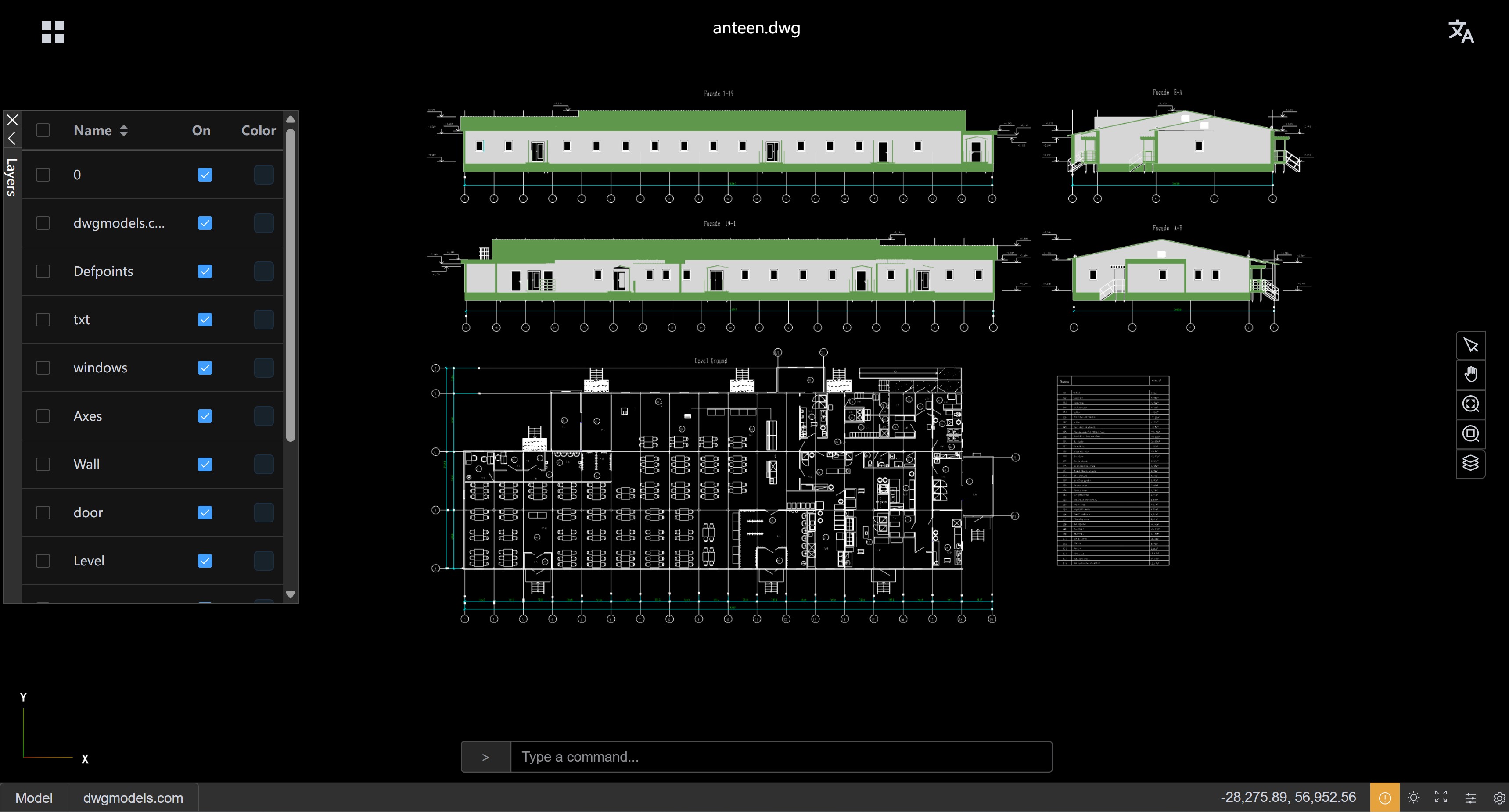MLightCAD
CAD-Viewer
CAD-Viewer is a high-performance, modern, web-based CAD editor inspired by AutoCAD. It enables users to view and edit DWG/DXF files entirely in the browser without requiring any backend server, providing exceptional rendering speed and smooth interactions. The project is modular and designed for seamless integration with other applications.

Features
- High-performance viewing of large DWG/DXF files with smooth 60+ FPS rendering
- No backend required - Files are parsed and processed entirely in the browser
- Enhanced data security - Files never leave your device, ensuring complete privacy
- Easy integration - No server setup or backend infrastructure needed
- Modular architecture for seamless third-party integration
- Offline and online editing workflows
- THREE.js 3D rendering engines with advanced optimization techniques
- Designed for extensibility and integration with platforms like CMS, Notion, and WeChat
How to Use
Desktop Browser Operations
- Select: Left-click on entities
- Zoom in/out: Scroll mouse wheel up/down
- Pan: Hold middle mouse button and drag
Pad/Mobile Browser Operations
- Select: Tap on entities
- Zoom: Pinch with two fingers
- Pan: Single-finger drag
Performance
CAD-Viewer is engineered for exceptional performance and can handle very large DXF/DWG files while maintaining high frame rates. It employs multiple advanced rendering technologies to optimize performance:
- Custom Shader Materials: Uses GPU-accelerated shader materials to render complex line types and hatch fill patterns efficiently
- Geometry Batching: Merges points, lines, and areas with the same material to dramatically reduce draw calls
- Instanced Rendering: Optimizes rendering of repeated geometries through instancing techniques
- Buffer Geometry Optimization: Efficient memory management and geometry merging for reduced GPU overhead
- Material Caching: Reuses materials across similar entities to minimize state changes
- WebGL Optimization: Leverages modern WebGL features for hardware-accelerated rendering
These optimizations enable CAD-Viewer to smoothly render complex CAD drawings with thousands of entities while maintaining responsive user interactions.
Known Issues
CAD-Viewer has some known limitations that users should be aware of:
- Unsupported Entities:
- Tables (DWG files only): Table entities are not currently supported in DWG files because LibreDWG is used to read DWG files and it doesn't support table entity yet. If one table is created by line and polyline entities, definitely it is supported.
- XRefs: External references (XRefs) are not supported and will not be displayed.
- DWG File Compatibility: Some DWG drawings may fail to open due to bugs in the underlying LibreDWG library. This is a known limitation of the current DWG parsing implementation. If you find those issues, please log one issue on CAD-Viewer issues page or LibreDWG issues page.
These issues are being tracked and will be addressed in future releases.
Roadmap
To achieve the final goal, the following milestones are defined:
- [x] DWG/DXF Viewer: Create an offline web viewer for DWG/DXF files.
- [x] Entity Editing Framework: Support drawing modification.
- [ ] Integration: Integrate the DWG/DXF viewer into other applications or frameworks (e.g., CMS, Notion, OpenLayers).
- [ ] WeChat App: Develop a WeChat app to display DWG/DXF files within WeChat.
- [ ] Offline CAD Editor: Build an offline CAD editor that allows users to modify DWG/DXF files in the browser and store changes locally.
- [ ] Online CAD Editor: Add backend support to enable users to store changes to DXF/DWG files in the cloud.
Note:
The second item is partially finished now. While CAD-Viewer doesn't support saving modificaiton to DWG/DXF files now, it provides comprehensive support for modifying drawings in real-time. You can add, edit, and delete entities within the drawing by RealDWG-Web API, and the viewer will automatically update to reflect these changes. The usage patterns of RealDWG-Web API are very similar to AutoCAD RealDWG. If you're familiar with AutoCAD RealDWG development, you'll find the API structure and workflow nearly identical. Please refer to cad-simple-viewer README to get more details.
Which Viewer Should I Use?
This project provides two viewers cad-viewer and cad-simple-viewer for users. Which viewer to choose depends on your project requirements and desired level of integration:
Use cad-viewer if:
- You want a ready-to-use Vue 3 component with a modern UI, dialogs, toolbars, and state management.
- You need to quickly embed a high-performance CAD viewer/editor into your Vue application with minimal setup.
- You prefer a solution that handles file loading, rendering, layer/entity management, and user interactions out of the box.
- You want seamless integration with optimized SVG and THREE.js renderers, internationalization, and theming.
- You do not want to build your own UI from scratch.
Recommended for: Most web applications, dashboards, or platforms that need to display CAD files with a polished user interface.
Use cad-simple-viewer if:
- You need core CAD logic only (document management, command stack, rendering engine integration) without any UI framework dependencies.
- You want to build your own custom UI or integrate CAD functionality into a non-Vue or non-web environment.
- You require maximum flexibility and performance for handling large CAD files, and plan to connect the logic to your own rendering or UI layer.
- You want a framework-agnostic solution that provides only the essential CAD operations and canvas rendering.
Recommended for: Custom integrations, headless CAD processing, or advanced users building highly tailored CAD solutions.
Summary Table:
| Package | UI Provided | Framework | Use Case |
|---|---|---|---|
cad-viewer |
Yes | Vue 3 | Turnkey CAD viewer/editor with modern UI |
cad-simple-viewer |
No | None | Core CAD logic for custom or headless use |
For more details, see the cad-viewer README and cad-simple-viewer README.
Examples
cad-simple-viewer-example: Example application demonstrating how to use thecad-simple-viewercomponent in a real project.cad-viewer-example: Example application demonstrating how to use thecad-viewercomponent in a real project.
Contributing
Contributions are welcome! Please open issues or pull requests for bug fixes, new features, or suggestions. For bug reports, providing a link to the problematic drawing will help in reproducing and fixing the issue.